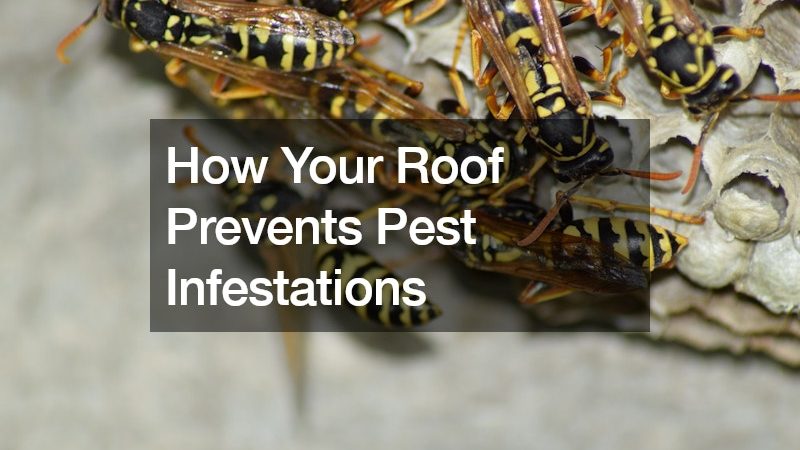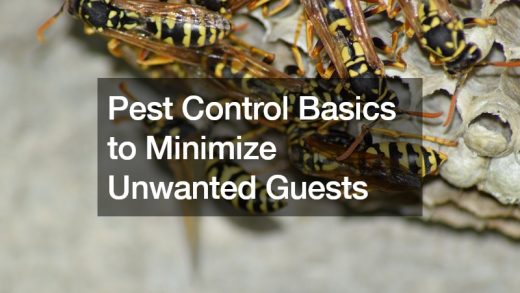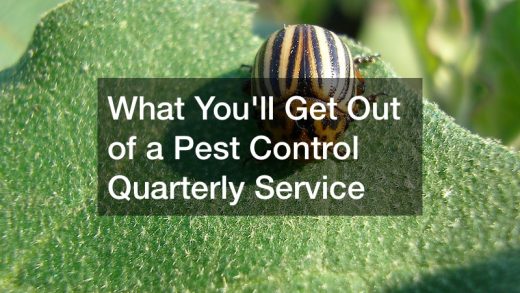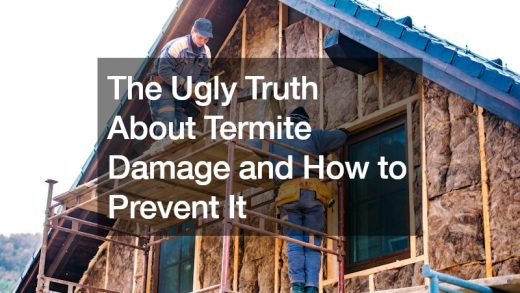How Your Roof Prevents Pest Infestations

Owning a home requires consistent maintenance and inspections, especially when you’re attempting to prevent a pest infestation. If you want to better protect your home and property, you can do so by taking a bit of time to learn how your roof prevents pest infestations. Whether you’ve installed a slate, standard shingle, or flat commercial roof, you’ll want to know how a roof and its maintenance can prevent a pest infestation at any stage in your homeownership.
Entry Barrier

One of the most obvious ways of how your roof prevents pest infestations is that it provides a barrier against entry into your home altogether. The right roof that is well-maintained and suitable for the climate or region you’re living in is more likely to protect your home from outside rain, snowfall, and even debris or pests. When there are no missing shingles or gaping holes, it’s also much easier to keep pests at bay and prevent your home from becoming a target of their new nest or breeding ground.
If you notice that your roof is missing shingles or has sitting or standing water, you may need to call a local roofing service to inquire about roof repairs or even roof replacement services, depending on the shape and condition of your roof. Calling on roofing professionals is essential when you’re serious about protecting your investments anywhere in or around your home, including its exterior. A professional roofing contractor or company will not only be licensed and insured to work on residential homes similar to your own, but they will also have the experience to do so without missing a potential issue or a problem that can turn expensive quickly.
Whether you’ve just moved into a brand-new home that was recently built or you’ve invested in a home that was built in the 1950s, conducting a roof inspection regularly or at least seasonally is recommended. If you’re truly determined to become more knowledgeable of the process of protecting your home from pests without the help of professionals, you’ll also want to take some time to get to know more about the fauna, flora, and climate region you’re located in. The more educated and knowledgeable you are of your surroundings, the easier it’ll be for you to find the right pest traps and deterrents that work well with the type of roof you have installed and in place.
Suitable Ventilation
When you’re discovering how your roof prevents pest infestations, you’ll want to consider how the ventilation is in your home and with your existing roof. Ventilation is essential if you live in a climate or region that is prone to moisture, rainfall, or even snow. If you’re learning how your roof prevents pest infestations, you’ll need to ensure your roof has suitable ventilation to prevent the buildup of moisture or rain, especially after or during a storm or natural disaster.
If you have poor ventilation in your roof or the attic space of your home, there’s a much greater chance of requiring bug exterminators at some point or another, even if you’re vigilant in your home inspections. When you want to mitigate or minimize the number of roof repairs you require as a homeowner, you’ll need to ensure that your attic and roof space have proper ventilation year-round. Preventing the buildup of moisture and allowing proper airflow can go a long way in protecting your roof and attic.
If you’re unsure if your ventilation is being properly maintained or if your roof is ventilated at all, you’ll also want to work with a local roofing contractor or company near you. Calling a local roofing contractor you can trust is a way to conduct a thorough inspection not only of the exterior of your home’s roof, but also of your attic or crawl space inside your home. To learn more through the process, inquire about tagging along with any contractor you’ve hired to inspect your attic space.
When you begin inspecting your home’s attic space, you’ll want to do so while wearing protective gloves and in some cases, even protective masks or respirator gear, depending on the type of insulation you have in place and any issues you’re having specifically at the time. The more prepared you are, the easier it will be for you to remain focused once you begin inspecting the attic and roof interior. Inquire about the current condition of your home’s insulation and the location of any vents that are helping to keep your home dry whenever you’re working alongside a roofing professional during the process of a roof inspection.
Gutter Maintenance Benefits

Keeping your home’s gutters clean and clear of debris is essential if you’re interested in preventing pests from invading your home. When it comes to learning how your roof prevents pest infestations, gutter maintenance and cleaning is essential. Ongoing gutter maintenance is imperative whether you live in a dry climate or region or if you’re in an area that is prone to natural disasters and heavy rainfall.
Maintaining your home’s gutters will prevent buildup and debris from clouding your roof, causing it damage, or allowing water to sit, ultimately degrading your roof’s material. If you’re unfamiliar with the process of inspecting your home’s gutters, you can also choose to turn to a local contractor or a professional roofing company in your area, depending on the resources near you at the time.
Taking the time to inspect your home’s gutters routinely can also inform you of their current condition and whether they require replacement or upgrades and updates. Depending on the type of gutters you have installed around your home, you’ll also want to routinely inspect them after a storm to prevent the buildup of debris or in serious instances, even complete blockages. Allowing debris to build up in your gutters can quickly cause issues on your roof, including standing or sitting water as well as damage from the debris itself.
Even if you’re new to inspecting your home’s gutters, you can also do so on your own before calling in the professionals with proper safety gear, equipment, and the right ladder in place. Once you’re comfortable climbing a ladder and securing safety equipment, you can inspect your home’s gutters, especially if you live in a one-story home. If you’re living in a home that is larger than one-story, and you’re new to being a homeowner, it is always best to turn to professional contractors or those who work in roofing to ensure the best outcome possible.
Once a professional roofing contractor or company arrives at your home, you’ll have the opportunity to get to know more about the type of gutters you have installed, the materials used, and the overall condition of the gutters in place. This will help you determine if you may need to invest in new gutters to help better protect your roof and, ultimately, your home from a potential pest infestation. Maintaining gutters year-round is just as important as conducting traditional roofing inspections.
Keep Your Trees Trimmed
Your roof will protect your home from pests so long as it remains clear from potential risks or pests themselves. One way to ensure your roof is protecting your home as best as possible is to keep any surrounding trees on your property trimmed and well-maintained. Properly trimmed trees will help prevent pests from making your property their home, especially if they typically build nests or thrive in and around the type of trees you have on your lot.
If you’re learning how your roof prevents pest infestations, you’ll need to keep the overall maintenance of your home’s trees in check. Proper maintenance includes inspecting your surrounding trees throughout each season and especially as the seasons begin to change and turn. The more aware you are of the health, condition, and size of the trees you have on your property, the easier it’ll be for you to determine when the time is right to call on professional landscapers or a local tree-trimming company near you.
Similarly to when you’re searching for basement crack repairs or roofing installation specialists, you’ll also want to take a bit of time to find the right tree trimmers near you. Whether you prefer working with an individual tree trimmer or if you’d rather work with a local tree-trimming company that is well-known in the area, consider your options before you choose who to hire for the job. You’ll also want to keep the intensity and duration of the job in mind, especially if you may require help consistently over an entire season or a set period.
Choosing the Right Materials

When it comes to being a homeowner, you’ll want to ensure your roof is made of the proper material. The type of material you select for your home’s roof should not only reflect your budget and available providers, but also the climate and region you’re located in. The more familiar you are with various roof types, the easier it’ll be for you to find a roof that helps in preventing a pest infestation, even over the course of time.
If you’re committed to knowing how your roof prevents pest infestations, selecting proper roofing materials is imperative. Working with local roofers and even a trusted roofing company is one of the best ways to dive in when you’re ready to begin asking questions regarding the type of roofing that is optimal for your home. Asking questions and getting to know more about slate roofs, shingles, modern solar panels, and even commercial-grade flat roofs can help with making an informed decision once you’re ready to make your investment.
Learning about roofing, attic, and exterior materials can be tricky, depending on the type of home you’re living in. If you’re interested in diving deep into protecting your home from pests, you can also do so by working with siding contractors or, in some cases, even brick restoration specialists, depending on your location and particular needs at the time. Working with the right professionals can help you learn more about various methods that can be deployed or implemented to protect your property, home, and surrounding lot from a potentially invasive and devastating pest infestation.
Pest Deterrents
In some cases, when you are researching how your roof prevents pest infestations, you might come across various deterrents that can be utilized outdoors and even on your roof, depending on the type of pest infestation you’re experiencing. Using everything from traditional pest-deterrent vents and mesh screens to the use of bird spikes around certain locations of your roof and yard can prevent pests from invading your space.
When you’ve just discovered a pest infestation for the first time, you’ll want to learn more about the types of pests you are dealing with before settling on a deterrent. The more familiar you are with the life cycle, habitation requirements, and cyclical behaviors of a pest, the easier it’ll be for you to pinpoint the best course of action to take. From using outdoor pest deterrent sprays and repellents to installing physical barriers, there are many different ways to approach a pest infestation in or around your home, depending on your location and the type of pest you’re dealing with at the time.
If you’re still unsure of which route to go when it comes to pest deterrents and even roof inspections, reaching out to local roofing companies is a must. When you work with a residential roofing company, it’s much easier to ask questions regarding your roof’s overall condition and the risks you have as a homeowner when it comes to pest infestations. The more questions you ask, the easier it’ll be to determine which route you want to go regarding repairs, replacements, and even insulation solutions.
Learning how your roof prevents pest infestations is essential when you’re a homeowner, whether you intend to sell your home soon or if you plan to live on your property for decades to come. Preventing a pest infestation is not only a way to alleviate stress, but it can also protect the value and appeal of your home, regardless of its size and location. The more familiar you are with how your roof prevents pest infestations, the easier it’ll be for you to conduct the necessary maintenance to protect and preserve your roof for many more years to come.


